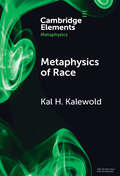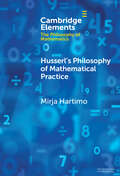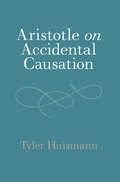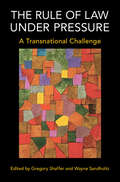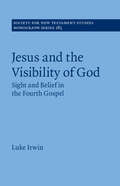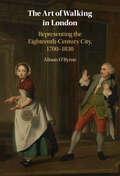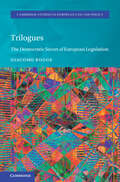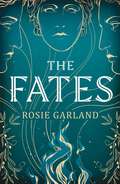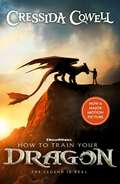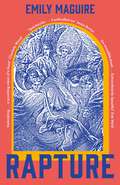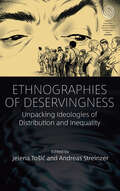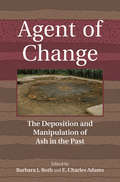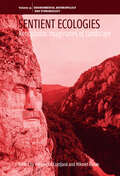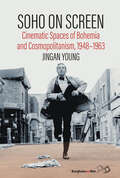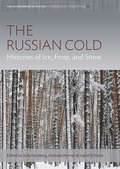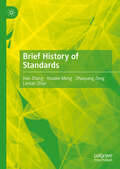- Table View
- List View
Metaphysics of Race (Elements in Metaphysics)
by Kal H. KalewoldAre races real? Is race a biological or social category? What role, if any, does race play in scientific explanations? This Cambridge Element addresses these and other core questions in the metaphysics of race. It discusses prominent accounts of race such as biological racial realism, social constructivism about race, and racial anti-realism. If anti-realists are right, our societies find themselves in thrall to a concept that is scarcely more veridical than 'witch' or 'werewolf'. Social constructionism grounds race in factors ultimately controlled by human thought and action. Biological racial realists argue that race is too quickly dismissed as biologically meaningful, and that it has a role to play in contemporary life sciences. The Element explores these views and shows their virtues and shortcomings. In particular, it advances an argument against biological racial realism that draws on the metaphysics of naturalness and philosophy of biology and medicine.
Husserl's Philosophy of Mathematical Practice (Elements in the Philosophy of Mathematics)
by Mirja HartimoHusserl's Philosophy of Mathematical Practice explores the applicability of the phenomenological method to philosophy of mathematical practice. The first section elaborates on Husserl's own understanding of the method of radical sense-investigation (Besinnung), with which he thought the mathematics of his time should be approached. The second section shows how Husserl himself practiced it, tracking both constructive and platonistic features in mathematical practice. Finally, the third section situates Husserlian phenomenology within the contemporary philosophy of mathematical practice, where the examined styles are more diverse. Husserl's phenomenology is presented as a method, not a fixed doctrine, applicable to study and unify philosophy of mathematical practice and the metaphysics implied in it. In so doing, this Element develops Husserl's philosophy of mathematical practice as a species of Kantian critical philosophy and asks after the conditions of possibility of social and self-critical mathematical practices.
Aristotle on Accidental Causation
by Tyler HuismannIn this major new study, Tyler Huismann connects Aristotle's natural philosophy to modern theories of causation and provides fresh interpretations of classic issues. He links two of the most important notions in Aristotle's philosophy, accidents and causes, and using the concept of accidental causation as a guide, argues for ground-breaking proposals on some of the most foundational areas of Aristotle's thought: the relation between substances and accidents, the nature of efficient causation, the workings of 'qua,' the possibility of uncaused events, and the role of accidental causation in the natural world. Structured around close readings of Aristotle's Physics and Metaphysics and informed by contemporary theories of causation, Huismann's book offers students an accessible treatment of some of Aristotle's core texts, and provides specialists with a series of provocative interpretations.
Hidden Music: The Composer's Guide to Sonification (Elements in Twenty-First Century Music Practice)
by Milton MermikidesThis book explores the intersection of data sonification (the systematic translation of data into sound) and musical composition. Section 1 engages with existing discourse and offers an original model (the sonification continuum) which provides perspectives on the practice of sonification for composers, science communicators and those interested in this rapidly emerging field. Section 2 engages with the sonification process itself, exploring techniques, models of translation, data fidelity, analogic and symbolic data mapping, temporality and the listener experience. In Section 3 these concepts and techniques are all made concrete in the context of a selection of the author's projects (2004–2023). Finally, some reasons are offered on how sonification as a practice might enrich composition, communication, collaboration, and a sense of connection.
Elements of Purity (Elements in the Philosophy of Mathematics)
by Andrew AranaA proof of a theorem can be said to be pure if it draws only on what is 'close' or 'intrinsic' to that theorem. In this Element we will investigate the apparent preference for pure proofs that has persisted in mathematics since antiquity, alongside a competing preference for impurity. In Section 1, we present two examples of purity, from geometry and number theory. In Section 2, we give a brief history of purity in mathematics. In Section 3, we discuss several different types of purity, based on different measures of distance between theorem and proof. In Section 4 we discuss reasons for preferring pure proofs, for the varieties of purity constraints presented in Section 3. In Section 5 we conclude by reflecting briefly on purity as a preference for the local and how issues of translation intersect with the considerations we have raised throughout this work.
The Rule of Law under Pressure: A Transnational Challenge
by Gregory Shaffer Wayne SandholtzThe Rule of Law Under Pressure provides readers with an accessible and richly detailed assessment of recent challenges to the rule of law. The rule of law is closely tied to both democracy and human rights. The erosion of the rule of law, within a rising number of countries and in international relations, places populations under increasingly authoritarian and rights-abusing governments and threatens to destabilize peaceful relations among states. The book brings conceptual clarity to this complex and multidimensional topic and assesses recent trends in the rule of law at both national and international levels. The opening chapter clearly sets out the key concepts and evaluates broad transnational trends in the rule of law. Succeeding chapters assess rule of law developments at the international level and within key countries around the world. This title is also available as Open Access on Cambridge Core.
Jesus and the Visibility of God: Sight and Belief in the Fourth Gospel (Society for New Testament Studies Monograph Series)
by Luke IrwinAlthough scholars have debated the link between empirical senses and belief in the Gospel of John, few have queried their own presuppositions about the invisibility of God. In this study, Luke Irwin establishes the value of God's physical incarnation for belief, arguing that the theological nature of belief derives from a God who makes himself physically visible in the world. Irwin builds on recent work on divine embodiment in the Hebrew Bible and New Testament and illuminates the Jewish context for John's Gospel. He also explains John's understanding of 'seeing' as a positive component of belief-formation and resolves the Johannine relationship between 'seeing' and 'believing'. Showing how God is the ultimate target of belief, Irwin argues that unless God becomes physically visible in Jesus, belief cannot be attained.
The Art of Walking in London: Representing the Eighteenth-Century City, 1700–1830
by Alison O'ByrneExploring a variety of perspectives on London during the long eighteenth century, this study considers how walking made possible the various surveys and tours that characterized accounts of the capital. O'Byrne examines how walking in the city's streets and promenades provided subject matter for writers and artists. Engaging with a wide range of material, the book ranges across and investigates the various early eighteenth-century works that provided influential models for representing the city, descriptions of the promenade in St. James's Park, accounts of London that imagine the needs and interests of tourists, popular surveys of the cheats and frauds of the city uncovered on a ramble through London, and comic explorations of the pleasures and pitfalls of urban living produced in the late eighteenth and early nineteenth century. Convincing and engaging, O'Byrne demonstrates the fundamental role played by walking in shaping representations of the eighteenth- and early nineteenth-century city.
Storefront Campaigning (Elements in Campaigns and Elections)
by Joshua P. Darr Sean WhyardSince Barack Obama's historic and unprecedented field operations in 2008 and 2012, campaigns have centralized their voter contact operations within field offices: storefronts rented in strategically chosen communities. That model was upended in 2020: Joe Biden won the election without any offices (due to COVID-19), while Donald Trump's campaign opened over 300. Using two decades of data on office locations and interviews with campaign staffers, we show how the strategic placement and electoral impact of local field offices changed over the past twenty years, including differences in partisan strategy and effectiveness. We find that offices are somewhat more effective for Democrats than Republicans, but Democratic field operations are declining while Republicans' are increasing. We conclude by assessing whether future campaigns will invest in offices again – or if the rebirth of storefront campaigning is over and the future of political campaigning is purely digital.
Understanding and Coping in Social Relationships with Narcissists (Elements in Applied Social Psychology)
by Amy B. BrunellNarcissism is a trait that comes in different forms (agentic, communal, and vulnerable), which are all marked by characteristics such as entitlement, self-centeredness, and little empathy for others. One reason narcissism has gained attention among scholars and laypeople alike is because of its implications for social relationships. Narcissists' behaviors frequently have negative consequences for others. Whether their relationships are with coworkers or close relationship partners, interactions with narcissists can be challenging and emotionally taxing. Despite this, there is a sparse amount of research that addresses how to cope with difficult narcissistic relationships. This Element includes an overview of the trait forms of narcissism and discusses its implications for their social relationships. It provides a background about the development of narcissism and offers some research-informed suggestions for how to cope in narcissistic relationships. Future directions for research are also discussed.
Self and Body in Early East Asian Thought (Elements in Ancient East Asia)
by Mark Edward LewisThis Element examines evolving methods of cultivating the embodied self, including healing diseases and creating a superior person, in late Warring States and early imperial East Asia. It analyses many topics, including the textualization of bodily regimens and therapies, their systematization, their dissemination among different (and sometimes rival) social groups, and the diversity of traditions – religious, pharmacological, nourishing of life – that contested and combined to form a hegemonic medical practice. These topics in turn feature several issues: models of the body, regimens of cultivating and extending vitality, models of disease, and therapies for these ailments. All these ideas will be refined and extended through comparison with early Western medical traditions.
Trilogues: The Democratic Secret of European Legislation (Cambridge Studies in European Law and Policy)
by Giacomo RuggeThe events of the last ten years have shaken the “permissive consensus” that kept the European integration process going for many years. 'Output democracy', as based on decisions presumably meeting the needs of the citizens, is no longer enough to obtain public support. Never before has a process-oriented approach to European democracy been more urgent. This book aims to address this urgency, by providing an account of the European legislative process that is less conventional and does justice to the democratic potential inherent in trilogues. In particular, this book provides: a comprehensive reconstruction of the workings of trilogues, relying on internal documents collected through a series of access to documents requests; gives meaning to the legal notion of informality, understood as one of the most defining, although elusive, features of trilogues; squares the practice of trilogues with the European democratic order of the Treaties, showing that such a practice is compatible with a model of 'negotiation democracy'.
Rainbows End in Ferry Lane Market: perfect escapism from the author of THE CORNER SHOP IN COCKLEBERRY BAY (Ferry Lane Market)
by Nicola MayBook Three in bestselling sensation Nicola May's gorgeous new series - catch up with Book One, WELCOME TO FERRY LANE MARKET, and Book Two, STARRY SKIES IN FERRY LANE MARKET, now!39-year-old Glanna Pascoe - also known as 'the Rainbow Painter' - runs the Hartmouth Gallery in Ferry Lane Market in Cornwall. She is just getting her head and broken heart around being single, childless, and sober when Cupid flies in, shooting arrows all over the place.Meeting the mysterious and fascinating Isaac Benson, famous local artist, and recluse, allows Glanna's disillusioned heart and attitude to soften, and she begins to learn more about herself than she ever thought possible. Confused by her growing feelings for Isaac, Glanna throws herself into organising a life-drawing class at her gallery, using both male and female nudes - and setting local tongues wagging.A theft from her gallery and the return of ex-love Oliver Trueman cause Glanna to wonder if a pot of gold will be appearing at the end of her rainbow. And will it bring her the happiness, she has sought for so long?*** Discover the rest of the series! Starry Skies in Ferry Lane Market and Welcome to Ferry Lane Market are available now, and A Holiday Romance in Ferry Lane Market is coming soon! *** Praise for Nicola May!'This book will twang your funny bone & your heartstrings' - Milly Johnson'A fun and flighty read' - Sun'A funny and fast-paced romp - thoroughly enjoyable!' WOMAN Magazine'One of those books that I can't stop thinking about way after I've read it! - Kim The Bookworm'This book is so addictive that you will literally lose 3 hours of your life, and you won't care!' - Cara's Book BoudoirReaders love Nicola May, too!'A FABULOUS must-read' - 5 STARS'An excellent book of friendship - with a little wickedness!' - 5 STARS'Good for the soul' - 5 STARS'I loved it and devoured it in a matter of days' - 5 STARS'A wonderful, feel-good novel with some grit thrown in' - 5 STARS'Marvellous, beautiful and heart-warming' - 5 STARS'Sea, sand and sex - a soppy delight' - 5 STARS'A truly lovely book' - 5 STARS'Fun and whimsy, plus a dog!' - 5 STARS
The Fates: A spellbindingly original mythical retelling for 2024
by Rosie Garland'A really thrilling and totally original story of Greek mythology that I can't recommend highly enough' JENNIFER SAINT Before Gods and mortals, there were The Fates . . . You've heard the legends: three sisters born out of Nyx's darkness, destined to weave the lives, and deaths, of humankind for eternity.But immortality is a heavy burden, and Clotho, Lachesis and Atropos are captivated by the gloriously human lives of the mortals below, especially those of the great warrior Atalanta and her ill-fated lover, Meleager.However, being a Goddess of Fate doesn't make you a master of it. Will these three sisters find a way to free the couple, and themselves, from their destinies? Or will they be bound by Fate forever?READERS LOVE THE FATES'An absolutely stunning read!' ⭐⭐⭐⭐⭐ READER REVIEW'Out of everything I have ever read, I honestly think this has been my favourite book' ⭐⭐⭐⭐⭐ READER REVIEW'Fresh and welcoming . . . reading this felt like how listening to a new beautiful song feels' ⭐⭐⭐⭐⭐ READER REVIEW'I absolutely adored this book' ⭐⭐⭐⭐⭐ READER REVIEW'Exquisitely written with relatable and likable characters and beautiful world building' ⭐⭐⭐⭐⭐ READER REVIEW'Had me hooked from the first page and is one of the most unique books inspired by mythology that I have read' ⭐⭐⭐⭐⭐ READER REVIEW
How to Train Your Dragon: Book 1 (How To Train Your Dragon)
by Cressida CowellRead the HILARIOUS books that inspired the HOW TO TRAIN YOUR DRAGON films! Hiccup Horrendous Haddock the Third is a smallish Viking with a longish name. Hiccup's father is chief of the Hairy Hooligan tribe which means Hiccup is the Hope and the Heir to the Hairy Hooligan throne - but most of the time Hiccup feels like a very ordinary boy, finding it hard to be a Hero. In the first How to Train Your Dragon book Hiccup must lead ten novices in their initiation into the Hairy Hooligan Tribe. They have to train their dragons or be BANISHED from the tribe FOR EVER!But what if Hiccup's dragon resembles an ickle brown bunny with wings? And has NO TEETH? The Seadragonus Giganticus Maximus is stirring and wants to devour every Viking on the Isle of Berk . . .Can Hiccup save the tribe - and become a Hero?How to Train Your Dragon is a major award-winning DreamWorks film series. There is also a new live action movie due to be released in 2025. The TV series, Riders of Berk, can be seen on CBeebies and Cartoon Network.
Slum Boy: One of the most moving accounts of non-fiction ever written
by Juano Diaz'ONE OF THE MOST MOVING ACCOUNTS OF NON-FICTION EVER WRITTEN' GUARDIAN 'If you like Shuggie Bain, then Slum Boy is for you' LEMN SISSAY'A heart-breaking, inspiring read' ALAN CUMMING'The best book we have ever read' GILBERT & GEORGEJohn MacDonald is a four-year-old boy growing up in the slums of Glasgow. His mother is an addict, who leaves him starving in their flat for days at a time.When a neighbour files a report, John is wrenched away from her and placed into the care system. There, he has experiences he's too young to understand which his eventual adoptive parents silence as he grows into a gay man within the Romani community.But John dreams of being reunited with his mother and will stop at nothing to find her. Slum Boy is abouthow, against all odds, John found a way to his mother and true identity, Juano Diaz.'Remarkable' TIMES LITERARY SUPPLEMENT'Beautiful. I hope it finds a million readers' ANDREW O'HAGAN'Compulsively readable' PATRICK GALEIn 2024, Juano Diaz was awarded the Pride Awards for LGBTQ+ Heroes Changing the World.
Rapture: ‘Spectacular . . . It enthralled me’ Jessie Burton, bestselling author of The Miniaturist and The House of Fortune
by Emily MaguireThe legend is only the beginning . . .'A spectacular story of shape-shifting, love and faith . . . It enthralled me'Jessie Burton, multi-million bestselling author of The Miniaturist and The House of Fortune'Astonishing . . . a scorching vision of a book'Charlotte Wood, Booker-shortlisted author of Stone Yard Devotional'A fierce, sexy, heady maelstrom of a book. It sucked me in from the first page'Kiran Millwood Hargrave, author of The Mercies'What an incredible book Rapture is. It has all the hallmarks of a great thriller - such tension - mixed with the quiet, confident beauty of Agnes' voice - her fury and her love'Evie Wyld, author of The Echoes 'Bold and unexpected, Rapture buzzes with life and energy . . . Extraordinary'Rosanna Pike, instant Sunday Times bestselling author of A Little Trickerie'Emily Maguire has created an earthy, visceral, and sensual tale, full of devotion, intrigue and passion . . . A stunning novel'Victoria MacKenzie, award-winning author of For Thy Great Pain Have Mercy On My Little PainNinth-century Mainz, in the heart of the Holy Roman Empire.Agnes is the motherless child of an English priest - a wild and brilliant girl with a deep, visceral love of God. But when tragedy strikes, she is suddenly forced to choose between what is expected of her and the life she has always dreamed of. Determined to find her own freedom, she disguises herself as a man, securing a place at the revered Fulda monastery and forever altering the course of her existence.Thus begins the life of John the Englishman: a matchless scholar and scribe of Fulda, then a charismatic heretic in an Athens commune and, by her middle years, a celebrated teacher in Rome. There, she dazzles the Church hierarchy with her knowledge of the old and new languages of Europe, theology and Church law, and finds herself at the heart of political intrigue in a city where gossip is a powerful - and deadly - currency.And when the only person who knows her identity arrives in Rome, she will risk everything to once again feel what it is to be known - and loved.A note from the author'Rapture is inspired by a thousand year-old story about a clever girl who dresses as a man to follow her lover to a monastery where she becomes a brilliant scholar and teacher, and eventually ends up - still in careful disguise - the most powerful person in Rome. I feel like this is the book I've been working towards for my whole writing life. The story of an ambitious woman in a world where women are supposed to be modest. A woman whose mind refuses to accept a small life, and whose body is reviled while remaining, for her, a source of great joy. A woman, who, like so many oppressed people throughout history, finds a way to subvert and resist. To be who she is without permission or approval.In Rapture this legendary, much-argued over figure is a flesh-and-blood woman of ingenuity, purpose and passion. Her name is Agnes, and I'm excited for you to meet her.'
Ethnographies of Deservingness: Unpacking Ideologies of Distribution and Inequality (EASA Series #45)
by Jelena Tošić Andreas StreinzerClaims around 'who deserves what and why' moralise inequality in the current global context of unprecedented wealth and its ever more selective distribution. Ethnographies of Deservingness explores this seeming paradox and the role of moralized assessments of distribution by reconnecting disparate discussions in the anthropology of migration, economic anthropology and political anthropology. This edited collection provides a novel and systematic conceptualization of Deservingness and shows how it can serve as a prime and integrative conceptual prism to ethnographically explore transforming welfare states, regimes of migration, as well as capitalist social reproduction and relations at large.
Agent of Change: The Deposition and Manipulation of Ash in the Past
by Barbara J. Roth E. Charles AdamsAsh is an important and yet understudied aspect of ritual deposition in the archaeological record of North America. Ash has been found in a wide variety of contexts across many regions and often it is associated with rare or unusual objects or in contexts that suggest its use in the transition or transformation of houses and ritual features. Drawn from across the U.S. and Mesoamerica, the chapters in this volume explore the use, meanings, and cross-cultural patterns present in the use of ash. and highlight the importance of ash in ritual closure, social memory, and cultural transformation.
Sentient Ecologies: Xenophobic Imaginaries of Landscape (Environmental Anthropology and Ethnobiology #31)
by Alexandra Coțofană Hikmet KuranEmploying methodological perspectives from the fields of political geography, environmental studies, anthropology, and their cognate disciplines, this volume explores alternative logics of sentient landscapes as racist, xenophobic, and right-wing. While the field of sentient landscapes has gained critical attention, the literature rarely seems to question the intentionality of sentient landscapes, which are often romanticized as pure, good, and just, and perceived as protectors of those who are powerless, indigenous, and colonized. The book takes a new stance on sentient landscapes with the intention of dispelling the denial of “coevalness” represented by their scholarly romanticization.
Migration in the Making of the Gulf Space: Social, Political, and Cultural Dimensions (Worlds in Motion #11)
by Lorenzo Casini Antía Mato BouzasCombining visual and literary analyses and original ethnographic studies as part of a more general political reflection, Migration in the Making of Gulf Space examines the role of migrants and non-citizens in the processes of settling in the Arab States of the Gulf region. The contributions underscore the aspirational character of the Gulf as a place where migrant recognition can be attained while also reflecting on practices of exclusion. The book is the result of an interdisciplinary dialogue among scholars and includes an original contribution by the acclaimed author of the novel Temporary People, Deepak Unnikrishnan.
Resettled Iraqi Refugees in the United States: War, Refuge, Belonging, Participation, and Protest (Forced Migration #47)
by Jared KeyelThe American war against Iraq has caused hundreds of thousands of deaths and displaced millions of people. Between 20 March 2003 and 30 September 2017, more than 172,000 Iraqis resettled in the United States. This book explores the experiences of fifteen Iraqis who resettled in the US after 2003. It examines the long war against Iraq that began in 1991 and the decisions some Iraqis made to leave their homes and seek refuge in the United States. The book also delves into the possibilities for belonging and cultural exchange for this cohort of Iraqis and their political engagement with non-profit organizations, advocacy, and activism against the 2017 Travel Ban.
Soho on Screen: Cinematic Spaces of Bohemia and Cosmopolitanism, 1948-1963
by Jingan YoungDespite Soho’s rich cultural history, there remains an absence of work on the depiction of the popular neighbourhood in film. Soho on Screen provides one of the first studies of Soho within post-war British cinema. Drawing upon historical, cultural and urban studies of the area, this book explores twelve films and theatrically released documentaries from a filmography of over one hundred Soho set productions. While predominantly focusing on low-budget, exploitation films which are exemplars of British and international filmmaking, Young also offers new readings of star and director biographies, from Laurence Harvey to Emeric Pressburger, and in so doing enlivens discussion on filmmaking in a time and place of intense social transformation, technological innovation and growing permissiveness.
The Russian Cold: Histories of Ice, Frost, and Snow (Environment in History: International Perspectives #22)
by Ingrid Schierle Julia Herzberg, Andreas RennerCold has long been a fixture of Russian identity both within and beyond the borders of Russia and the Soviet Union, even as the ongoing effects of climate change complicate its meaning and cultural salience. The Russian Cold assembles fascinating new contributions from a variety of scholarly traditions, offering new perspectives on how to understand this mainstay of Russian culture and history. In chapters encompassing such diverse topics as polar exploration, the Eastern Front in World War II, and the iconography of hockey, it explores the multiplicity and ambiguity of “cold” in the Russian context and demonstrates the value of environmental-historical research for enriching national and imperial histories.
Brief History of Standards
by Hao Zhang Youwei Meng Zhaoyang Zeng Lanlan ZhaoThis book takes the technological revolution and industrial changes as the background. The timeline uses the timeline to explain the path of changes in standard concepts since the millennium, showing the scientific system and gradually becoming the focus of the people. This book refers to the classics of a number of standard theories, introduces a number of standards and its theoretical content, and combines the industrial observation experience and typical cases accumulated by the author to put forward opinions on standards and standardization. As the awareness of standards gradually rooted in people's hearts, this book is not only an undergraduate reading, which meets the attention of readers, but also has some appeals to the academic, industry, and business circles to provide reference for the development of world standards.
